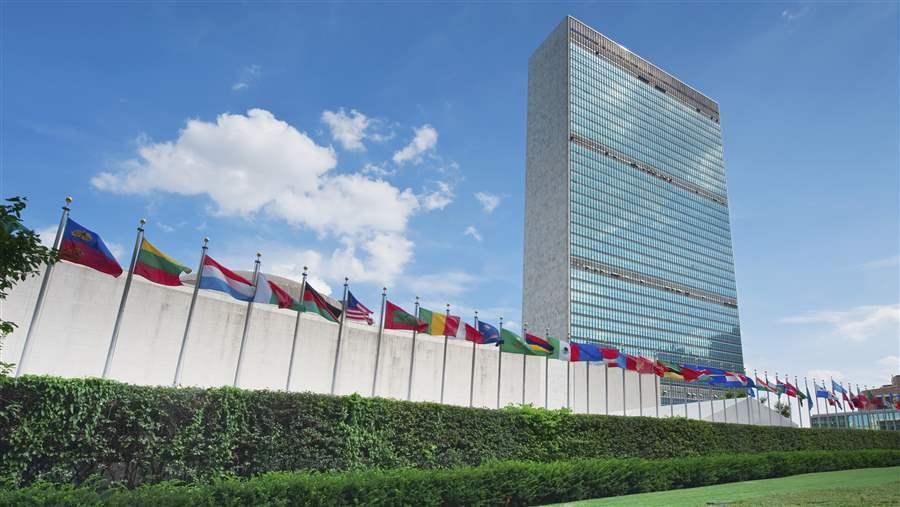The Road to High Seas Conservation
A timeline of the United Nations’ work to protect marine biodiversity in areas beyond national jurisdiction
Overview
For more than a decade, the United Nations and its member States have been on a journey to address one of the world’s most pressing environmental issues: how to protect marine biodiversity in areas beyond national jurisdiction, including the high seas, the nearly two-thirds of the ocean that falls outside the jurisdiction of any country.
Since 2004, United Nations decision makers have made steady progress, beginning with the global acknowledgment that these ocean areas—which have little overarching governance—need stronger protections and a comprehensive management structure. In June 2015, the United Nations General Assembly unanimously agreed to launch a series of four Preparatory Committee (PrepCom) negotiations to develop an international treaty to govern these areas.
The first two PrepCom meetings convened in March and August 2016 to discuss the key provisions that will appear in the treaty, among them mechanisms to conduct environmental impact assessments and establish marine protected areas, including marine reserves, on the high seas. With two final meetings set for 2017, it is critical that governments make good on their commitment to provide recommendations on elements of a draft treaty text so that the General Assembly can take a decision in 2018 to launch formal negotiations through an intergovernmental conference.
This timeline shows just how much progress has been made since the first U.N. working group met on this topic. It also shows the way forward. After traveling such a long road, U.N. member States should move swiftly towards the next steps in a process that will lead to greater conservation and sustainable use of the ocean areas we all depend on.
These dates represent the key moments in progress towards high seas conservation. With two final PrepCom meetings on the agenda for 2017, there are just a few milestones left until formal treaty negotiations can begin.
- 2004: “Conservation and sustainable use of marine biological diversity in areas beyond national jurisdiction” is featured as an emerging topic of concern at the fifth meeting of the U.N. Open-Ended Informal Consultative Process on Oceans and the Law of the Sea.
- 2006: The United Nations General Assembly convenes an Ad Hoc Open-Ended Informal Working Group to study issues relating to the conservation and sustainable use of the marine biological diversity beyond areas of national jurisdiction (BBNJ Working Group), which would meet nine times between 2006 and 2015.
- 2012: At the Rio+20 Conference on Sustainable Development in Rio de Janeiro, States commit to addressing “the issue of the conservation and sustainable use of marine biodiversity in areas beyond national jurisdiction (ABNJ), including by taking a decision on the development of an international agreement under UNCLOS,” the United Nations Convention on the Law of the Sea, before September 2015.
- January 2015: States at the final BBNJ Working Group meeting reach a consensus recommendation that the United Nations General Assembly “decide to develop an international legally binding instrument under the Convention on the conservation and sustainable use of marine biological diversity in areas beyond national jurisdiction.”
- June 2015: The United Nations General Assembly adopts Resolution 69/292, which establishes the PrepCom to make “substantive recommendations to the General Assembly on the elements of a draft text” of an international legally binding instrument on the conservation and sustainable use of marine biological diversity of ABNJ. The Resolution calls for four PrepCom meetings between 2016 and 2017, with a mandate to report to the United Nations General Assembly on their progress and recommendations by the end of 2017, and to reach a decision on launching an intergovernmental negotiating conference by September 2018.
- March-April 2016: The first PrepCom meeting kicks off discussion on the need for high seas protections.
- August-September 2016: At the second PrepCom meeting, States make progress on identifying areas of convergence of views within each of the negotiation issue areas.
- September 2016: IUCN World Conservation Congress attendees call on the United Nations General Assembly to launch an intergovernmental conference in 2018 to further develop an international agreement that allows for the establishment of marine protected areas and reserves to protect biodiversity on the high seas.
- March-April 2017: The third PrepCom meeting is expected to advance discussions and continue negotiations.
- July 2017: The fourth and final PrepCom meeting is due to be held.
- December 2017: The deadline for PrepCom to submit its report on progress and recommendations to the United Nations General Assembly on moving forward with international high seas treaty negotiations.
- September 2018: United Nations General Assembly to decide on the convening of and start date for an intergovernmental conference.
For further information, please visit: pewtrusts.org/highseas
The Pew Charitable Trusts is driven by the power of knowledge to solve today’s most challenging problems. Pew applies a rigorous, analytical approach to improve public policy, inform the public, and invigorate civic life.













